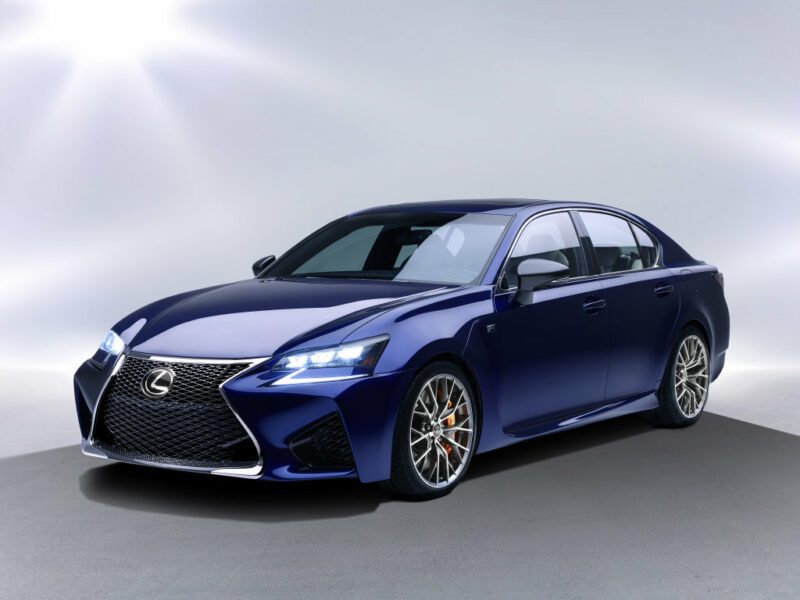
Lexus GS F Lux
Once again I felt the sound of purebred naturally aspirated V-XNUMX gasoline, and again the wound called normal emissions and fuel consumption opened up. While it's not true that turbocharged engines consume less fuel than naturally aspirated engines, at least not at wide open throttle, non-positively aspirated engines were created because of them right before a waste of history. There are very few left on the market, so we need to pay even more attention to them.
The Lexus GS F must compete with big-name (turbo) rivals such as the BMW M5, Audi S6 and Mercedes-AMG with the E 63 designation. But for this battle with the German Holy Trinity, it has the right weapon: five liters, V8, 477 "horse forces ", an eight-speed automatic transmission and what else, besides the rear-wheel drive. And the price: for the base one you will have to deduct 123 thousand euros. Lexus needs little introduction as it is very successful as Toyota's luxury brand, especially in the United States. If you're smiling that you probably won't remember Lexus before buying a sports car because it has no tradition or proper knowledge, I would just like to point out the top-end LFA model. So it's not about ignorance or lack of mileage in this area. Let's not be picky: the GS F has less power than its competitors, but if we look strictly rational, it doesn't even matter if the difference between their power is 10, 20 or 30 percent, as always. many.
There is more than enough evidence for this claim: full throttle in a Lexus means a top speed of 270 kilometers per hour, 4,6 seconds from 0 to 100, frightened passengers and frightened users of public places. It is good that he announces his arrival with the sound of the engine, which is amplified by the speakers through the speakers. Speakers in the front of the cab provide ample audibility of the engine, while the rear speakers provide a rumbling exhaust pipe. It sounds strange, but the thing is effective. At first, the V-12 is quiet, smooth and not tiring at all for day-to-day tasks. With moderate driving, it consumes about 255 liters, which is not much for such a powerful and equipped car (um, you look at the shoes, 35/19 ZR 275 in the front and 35/19 ZR4.000 in the back). But poetry starts at 7.250 rpm and ends at just 12,3 rpm, when the engine (which has forged pistons, titanium intake and exhaust valves, and direct fuel injection that delivers a compression ratio of up to 1: XNUMX) breathes full lungs. and forget about the Mark Levinson sound system.
If you haven't caught the attention of passers-by with orange brake calipers, toxic blue paint, or carbon fiber accessories on the front and rear spoilers, you're sure to get it with sound. Low, usually V-XNUMX, but at higher revs, too, arrogantly healthy full and correct frequencies. Well, when you then switch the driving program from Eco to Normal and then boldly to Sport S and Sport S +, the fun can begin. Rear-wheel drive and a superb eight-speed automatic transmission with lug-assisted steering wheel shifting are perfect, and if they were quiet and smooth before, the combination is suddenly wild and roaring. The engine roars, the transmission breaks with every gear change, and the driver has big eyes when he has to keep the round two-ton car on the road.
He is assisted by the TVD (Torque Vectoring Differential) program, which controls the direction of torque to the bike with the best grip: the standard means that children go to kindergarten, slalom a hardy passenger on a mountain road and only track the driver with a helmet. on a suitable polygon. I honestly admit that I turned off the ESP system only twice: firstly, to check the responsiveness of the car without it working, and secondly, as an attempt to balance my madness by saying if I dare yet. The road was always wet, so the rear wheels jokingly wanted to go a much longer distance in a corner, which is pleasant on the track and a little scary on slippery Slovenian mountain roads.
You have to be very careful here. Due to the fact that we were driving in accordance with the rules of the road, the consumption was between 17 and 23 liters, the Dunlop tires lost some of the black clothes, despite the slippery base, and the side supports on the excellent seats, in addition to the ESP system, burned out in those few days. ... The driver liked everything. What didn't we like? Insufficiently responsive steering in the Sport S + driving program, some buttons and switches reminiscent of the Yaris or Auris, and an analog clock that showed return times too quickly. Jokes aside, the GS F has proven that Lexus also has a knack for building the right sports car, and has shown that it doesn't need the harshness of a BMW M5 to fully enjoy it behind the wheel. Even Lexus knows and knows how.
Alyosha Mrak photo: Sasha Kapetanovich
Lexus GS F Lux
Basic data
| Test model cost: | 122.900 € |
|---|---|
| Power: | 351kW (477 KM) |
Cost (up to 100.000 km or five years)
Technical information
| engine: | 8-cylinder - 4-stroke - V8 - petrol - displacement 4.969 cm3 - maximum power 351 kW (477 hp) at 7.100 rpm - maximum torque 530 Nm at 4.800-5.600 rpm. |
|---|---|
| Energy transfer: | the engine is driven by the rear wheels - 8-speed automatic transmission - front tires 255/35 ZR 19 (Dunlop Sport Maxx), rear 275/35 ZR 19 (Dunlop SP Sport 01). |
| Capacity: | top speed 270 km/h - 0-100 km/h acceleration 4,6 s - fuel consumption (ECE) 11,2 l/100 km, CO2 emissions 260 g/km. |
| Mass: | empty vehicle 1.865 kg - permissible gross weight 2.320 kg. |
| External dimensions: | length 4.915 mm - width 1.845 mm - height 1.440 mm - wheelbase 2.850 mm - trunk 482 l - fuel tank 66 l. |
